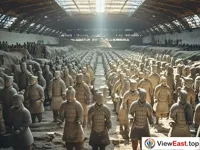

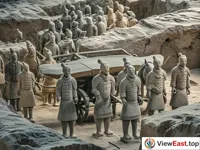
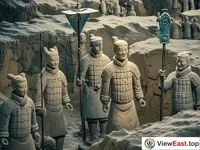
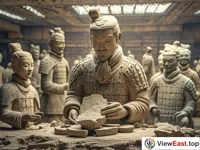
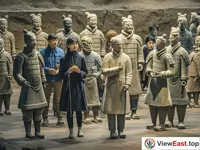
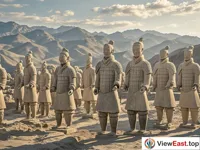

A. Scenic Spot Introduction
The Terracotta Army: The Millennial Sentinels of Xi'an
In the eastern coastal region of China, in Shaanxi Province's Xi'an City, lies a cultural and historical attraction known as the "Eighth Wonder of the World" — The Terracotta Army of Emperor Qin Shi Huang. This massive underground army, part of Emperor Qin Shi Huang's mausoleum, showcases the military might and artistic achievements of the Qin Dynasty.
Historical Culture:
The Terracotta Army was constructed to protect China's first emperor, Qin Shi Huang, in the afterlife. These life-sized soldiers, horses, and chariots were crafted to continue guarding the emperor in the next world. Each figure possesses unique facial features and expressions, reflecting the military organization and sculptural artistry of the Qin Dynasty.
Natural Landscape:
Though the Terracotta Army is a man-made wonder, the natural setting surrounding it adds to its mystique. Located at the northern foot of Mount Li, the mausoleum of Emperor Qin Shi Huang is enveloped by lush greenery, contrasting vividly with the ancient terracotta figures.
Cultural Characteristics:
The cultural significance of the Terracotta Army lies in its scale and meticulous detail. These terracotta figures are not only numerous but also meticulously crafted, with every detail from the texture of armor to the expressions on faces showcasing the exceptional skills of Qin Dynasty artisans.
Unique Experiences:
Visiting the Terracotta Army allows tourists to experience the history and culture of ancient China up close. Guided tours provide in-depth insights into the historical context and crafting techniques of each figure. Additionally, visitors can explore the nearby Qin Shi Huang's Mausoleum and museum to learn more about the history of the Qin Dynasty.
Stories and Metaphors:
The Terracotta Army is like a living history book, with each figure bearing the story of a soldier. Silently guarding the secrets of antiquity, they await the exploration and discovery of the world.
B. Travel Suggestions
Transportation Routes:
Starting from major cities in China, you can reach Xi'an City by plane or high-speed train. Xi'an Xianyang International Airport and Xi'an North Station are the main transportation hubs. Upon arrival in Xi'an, you can take a bus or taxi to the Terracotta Army Museum.
Tourism Convenience:
The tourism facilities around the Terracotta Army Museum are well-developed, offering a variety of hotels and homestays for tourists to choose from. Additionally, there are multiple service points within the museum that provide catering and rest services.
Accommodation, Food, and Safety:
Xi'an has good public safety and well-equipped tourism facilities. There are many specialty restaurants and snack bars offering various Shaanxi dishes, such as Roujiamo (meat stuffed in bread) and Liangpi (cold skin noodles).
Specialty Cuisine:
Xi'an is a famous city for its cuisine, and visitors can taste authentic Shaanxi snacks, such as Yangroupaomo (mutton stew with bread pieces) and Biang Biang Noodles, which are indispensable parts of experiencing the local culture.